|
Features,
Animals
for Adoption,
Out
and About Travel
News Elsewhere (fresh daily
from the Web) Home and
Garden News Elsewhere (fresh
daily from the Web)
|
|
Features
|
|
|
|
|
Animals
for Adoption
|
|
These animals and
more are available to good homes from the Logan County Animal
Control at 1515 N. Kickapoo, phone 735-3232.
Fees for animal
adoption: dogs, $60/male, $65/female; cats, $35/male, $44/female.
The fees include neutering and spaying.
Logan County Animal
Control's hours of operation:
Sunday – closed
Monday –
8 a.m. - 5 p.m.
Tuesday –
8 a.m. - 5 p.m.
Wednesday –
8 a.m. - 5 p.m.
Thursday –
8 a.m. - 5 p.m.
Friday –
8 a.m. - 3 p.m.
Saturday –
closed
Warden: Sheila Farmer
Assistant: Michelle Mote
In-house veterinarian: Dr. Lester Thompson
|
DOGS
Big to
little, most these dogs will make wonderful lifelong companions when
you take them home and provide solid, steady training, grooming and
general care. Get educated about what you choose. If you give them
the time and care they need, you will be rewarded with much more
than you gave them. They are entertaining, fun, comforting, and will
lift you up for days on end.
Be prepared to take the necessary time when you bring home a
puppy, kitten, dog, cat or any other pet, and you will be blessed.
[Logan
County Animal Control is thankful for pet supplies donated by
individuals and Wal-Mart.]
|
|
|
|
Ten reasons to adopt a
shelter dog
1.
I'll bring out your
playful side!
2.
I'll lend an ear to
your troubles.
3.
I'll keep you
fit and trim.
4.
We'll look out for each other.
5.
We'll sniff
out fun together!
6.
I'll keep you
right on schedule.
7.
I'll love you
with all my heart.
8.
We'll have a
tail-waggin' good time!
9.
We'll snuggle
on a quiet evening.
10.
We'll be
best friends always.
|
|
|
CATS
[Logan
County Animal Control is thankful for pet supplies donated by
individuals and Wal-Mart.]
|
|
Warden
Sheila Farmer and her assistant, Michelle Mote, look forward
to assisting you. |
| In
the cat section there are a number of wonderful cats to
choose from. There are a variety of colors and sizes.
Farm
cats available for free!
|
|
|

[Mixed kittens. One male, one female.
Will be good family pets or farm cats.]
|
|
|
|
|

|
|
Part
3
Funk
family members
had a wide range of talents
[SEPT.
24, 2001]
The
artifacts in the Funk Prairie Home and Gem and Mineral Museum
demonstrate that, while this colorful and prominent central Illinois
family were ahead of their time in farming practices, family members
also developed many other talents. DeLoss Funk, younger son of
LaFayette, for example, became an early expert in the new science of
electricity and wired his farm home for electricity 15 years before
the homes in nearby Bloomington had electric power.
|
|
[Click
here for Part 1]
[Click here
for Part 2]
Of
course, there were no power plants for DeLoss to hook into at that
time, so he built his own generator. The cement building close to
the house houses a gasoline engine that he built to power the 110
volt generator.
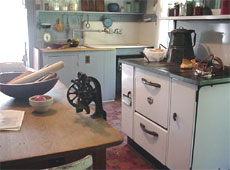
In the
kitchen, where the furniture is vintage 1910-1920s, DeLoss provided
outlets to the kitchen island
— a big wooden table
— that could
power a fan, a waffle iron, a toaster, a chafing dish and a vacuum
cleaner. In a time when irons, often called sad irons
because the amount of hard labor they required, were heated on a
wood or coal stove and rushed to an ironing table, the Funk family
had a choice of two types of electric irons: a shirtwaist iron and a
smoothing iron.
DeLoss
also provided his mother with an electric washing machine, attached
with a belt drive to a butter churn, so she could wash clothes and
churn butter at the same time. This was four years before the first
commercial electric washing machine was available, tour guide Bill Case explains.
The
Funks also had grass tennis courts, and DeLoss provided lights for
them so people could see to play at night. He also built a fountain
with colored lights in the formal flower garden south of the house,
which was used on special occasions.
The
upper floor of the house had five bedrooms and a nursery, as well as
another bathroom. In the guest bedroom was a tin ceiling and the
rest of the "fancy" furniture that came from Philadelphia:
a bed, a large dresser and a washstand. The large dresser has a
long, flat, hidden drawer in the bottom where the family could hide
their land deeds, the most valuable possessions they owned.
The
washstand was kept in the guest room even though the room contained
a sink with hot and cold running water. But because many folks at
that time were not familiar with running water and might have been
afraid to try using the sink, the Funks, always concerned for the
comfort of their guests, provided the washstand with a bowl and a
pitcher of water as well.
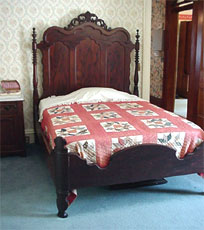
A bed
in one of the family bedrooms still has a corn shuck mattress. Former
caretaker Bertha Hedrick, who lived in the house, slept on the corn
shuck mattress for 15 years and said it was the best sleep of
her life. She described it as "like a crunchy waterbed but a
bit noisy."
The
Funks were democratic from the beginning, as the servant’s room
will attest. It is large and pleasant, with windows on two sides, a
comfortable bed, a desk, a wardrobe and chairs. It also has its own
stairway to the back porch, so the cook or caretaker who lived there
could come and go, or have visitors without disturbing the family or
being disturbed.
The
most unusual feature, however, is the painted floor. The other
floors upstairs are pine but are not painted. Paint was very
expensive in those days, Case explains, and the painted floor was a
sign of the high regard the family had for their help.
The
Funks paid their help well, Case says, and treated them much like
family members. In fact, some of the help married into the Funk
family.
When
LaFayette and Elizabeth died, DeLoss and his wife and three
daughters moved into the home. His family were the last Funks to
live in the Prairie Home. LaFayette’s other son, Eugene, usually
called E. D., and his family, four sons and four daughters, lived a
few miles down the road. E. D. raised, cattle, hogs and sheep, but
early on he turned his attention to improving corn. In 1901 he
formed the Funk Brothers Seed Company and began working to improve
the yield of corn and soybeans.
[to top of second column in
this section]
|
E.D.
began experimenting with closely bred families of corn and in 1916
marketed the first commercial "hybrid" corn, although that
corn was not the hybrid corn farmers know today. However, E.D. and
his staff kept working to develop corn that could withstand disease,
drought and the storms that leveled rows of corn in the fields, and
by the 1920s the Funk Farms near Bloomington had become a gathering
point for scientists interested in hybrid corn. By the mid-1920s
true hybrids were being developed, and by the mid-1930s new and more
effective strains of hybrid corn were coming from the Funk Farms
Experiment Station.
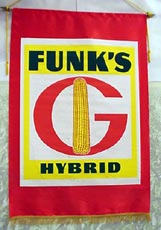
For
seven decades the company remained under the ownership and
management of the Funk family. E.D.’s son, Eugene D. Funk Jr.,
often known as Gene, continued the seed corn business and was
himself a prominent civic leader.
Another
of E.D.’s sons, LaFayette II, developed a lifelong fascination
with minerals and gems. LaFayette traveled worldwide as a
construction engineer for the Funk Seed Company, and on whatever
continent he was in, whether in Europe, South America, Asia or
Africa, he collected specimens.
His
collection became so extensive that he decided to build his own
museum on the grounds of the Funk Family Home in 1973. He also
donated collections of minerals to Illinois State University,
Wesleyan University and the University of Illinois. Still, the
building a few steps from the Prairie Home, which displays rocks on
the outside as well as the inside, houses room after room of
beautiful and unusual specimens that bring "rock hounds"
and mineralogists from all over the world to visit.
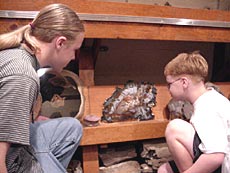
One of
the largest one-man collections in the world, most of the gems and
minerals are shown in their natural, uncut condition, but some are
cut and polished. There are also separate collections of fossils,
central Illinois Native American artifacts, Chinese soapstone
carvings, sea shells and corals, and a room of fluorescent minerals
which glow under ultraviolet light.
Next
to the Gem and Mineral Museum, a collection of posters and pictures
tells the story of the Funk Brothers Seed Company, and the visitor
will see signs advertising the well-known Funk’s G hybrid seed corn.
This part of the museum is still not complete, and new pieces are
added regularly.
A
collection of carriages that belonged to members of the Funk family,
along with one that belonged to their doctor, are also on display.
Another
Funk, Paul Allen, a brother of LaFayette II and Gene, is the
founder of the trust fund which maintains the Prairie Home and the
other museums. Still another descendent of the Funk family, Rey
Jannusch, a great-granddaughter of LaFayette I, is manager of the
home and curator of the museums.
Today,
on the south lawn are a formal flower garden and an herb garden. The
latter is planted and tended by the Herb Guild of McLean County and
is divided into sections: herbs for cooking, herbs for medicinal
use, herbs for dyeing and herbs used in biblical times.
In the
center of the herb garden is a knot garden, an arrangement of
low-growing flowers that should look from above as if they are tied
in a bow. Last year, Case said, the knot garden suffered damage in
the harsh cold weather.
Although the Funk Brothers
Seed Company is no longer an independent Bloomington-area business
and although Funks no longer live in the Prairie Home, the legacy of
this remarkable family still lives on in Illinois.
(For a tour of the Funk
Prairie Home and Gem and Mineral Museum, call (309) 827-6792. Tours
are available Tuesday through Saturday from 9 a.m. to 4 p.m., March
through December. Tours range from individuals to groups of 50 and
are free of charge.)
[Joan
Crabb]
|
|
|
Part
2
Funk home
was both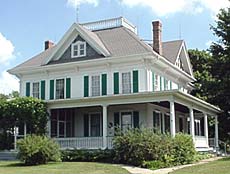
comfortable and impressive
[SEPT.
10, 2001]
When
LaFayette Funk brought his bride Elizabeth home to Illinois, he
presented her with his wedding gift — the spacious, graceful
13-room country home near Shirley, south of Bloomington, that is
today the Funk Prairie Home. He built it himself with lumber from
the family land at Funks Grove, just down the road.
|
|
[Click
here for Part 1]
When
he and Elizabeth moved in, in January of 1865, the house was not
completely finished inside. It took them 10 years to complete the
home and furnish it the way they wanted.
Although
first and foremost the Prairie Home was a home, LaFayette, like his
father, was a public person, and he often entertained visitors,
perhaps the governor or another state official, perhaps farmers from
the United States and other countries who came to see the model farm
on the Illinois prairie. The Funks were so far ahead of their time
in farming practices, people came from far away to learn from them,
according to Bill Case, guide and caretaker of the home.
LaFayette
followed in his father’s footsteps as a "cattle king"
and was a founder and director of the Chicago Union Stockyards. Like
his father, too, he was both a state representative and a state
senator. He was prominent in Illinois agriculture, serving for
nearly 25 years on the State Agricultural Board. This board worked
for laws which would benefit farmers, helped plan courses of study
at the University of Illinois agricultural college, and took part in
planning and staging the 1983 World’s Fair in Chicago.
So
LaFayette and Elizabeth’s home was both comfortable and
impressive. Guests entering the front hall saw a stamped tin ceiling
and a fine large hall tree, complete with mirror. The hall tree is
one of six pieces made by a carpenter "out east," where
the best furniture was made at that time.
LaFayette
and Elizabeth had gone to the United States Centennial in
Philadelphia in 1876, where they saw furniture that was made as a
gift for President Ulysses S. Grant. They had been saving money for
10 years to buy the kind of wood pieces they wanted, so they found
the firm that made Grant’s furniture and ordered six pieces for
their home on the prairie. Grant’s furniture is now in Blair House
in Washington, D.C., while LaFayette and Elizabeth’s furniture is
still in the Prairie Home, along with most of the other pieces they
purchased.
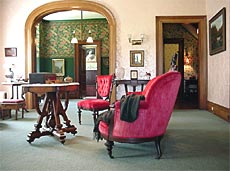
All
six pieces have a rosewood base, with burled walnut and, on most
pieces, bird’s eye maple veneer. Superb handiwork and detailed
wood carving make them still impressive 125 years later. Downstairs,
along with the hall tree, is a massive desk-bookcase, sometimes
called a "secretary," which sits in the library next to
the living room. A 10½-foot sideboard dominates the dining room.
The other three pieces are in the guest bedroom upstairs.
In the
parlor, just off the front hall, hang portraits of Isaac and
Cassandra, LaFayette’s parents. Here, too, is a Chickering square
grand piano, made by the famous Boston firm and bought by the Funks
in Chicago. Although most furniture was shipped by railroad at that
time, this piano was brought to the Funk home by oxcart, making the
trip from Chicago in just three days.
The
parlor, always the most elegant and least used room in a house of
that time, has a fine Italian marble fireplace (even though the home
had hot-water central heating), also a floor-to-ceiling pier glass
between two windows. The pier glass, Case explains, was called that
not because people "peer" into it, but because it came by
ship from Europe and had to be picked up at the dock or
"pier" when it was unloaded.
The
living room, separated from the parlor by a golden oak archway, was
the place for family and close friends to gather. Although this
room, too, has an Italian marble fireplace, the furniture is not so
impressive, just what people of that time could buy through the
Sears, Roebuck catalog.
The
highlight of the living room tour is the 1913 Victrola. Case winds
it up and puts on a record to play for visitors, perhaps the song
"To Any Girl," recorded in 1904 by Alexander Campbell and
Henry Burr.
[to top of second column in
this section]
|
Although recording techniques at that time did not pick
up bass sounds nearly as well as they do today, the music still
sounds amazingly good. Perhaps that is because of the bamboo needles
that play the thick, old 78 rpm records. The Funks always thought
ahead, so along with a huge supply of these bamboo needles, the
Funks also had a needle sharpener. Those needles will last another
hundred years, Case says.
Elizabeth,
a talented musician, must also have loved the Swiss music box that
sits on a small table in the living room. Case winds it up so
visitors can hear one of the five tunes it can play.
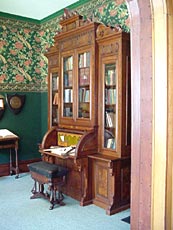
Off
the living room is the library, with the big secretary. Accessible
from both the library and the dining room was a real luxury for an
early farm family — an indoor bathroom with a zinc-lined tub and a
toilet. Water was pumped into a tank in the attic to operate the
gravity-flush toilet.
The
dining room could seat 16 comfortably for dinner. The big sideboard
and the bay window are focal points in the room.
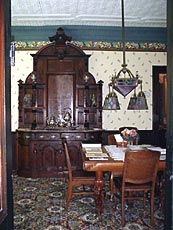
Not
only most of the furniture but even some of the houseplants are
original. On the plant stand in the bay window is Elizabeth’s
Christmas cactus, now 125 years old, which she brought back from the
United States Centennial celebration in Philadelphia in 1876. A
cutting from a night-blooming cereus, also 125 years old, is on the
plant stand as well.
On the
table is Volume I of the Funk-Stubblefield family tree. This book
has 800 pages, and Volume II is in the works.
Above
the table hangs an electric light fixture that looks as if it might
have been designed by Frank Lloyd Wright, or at least someone
well-known in the Arts and Craft movement. This, and the kitchen,
demonstrate that members of the Funk family possessed a wide array
of talents.
LaFayette
and Elizabeth had only three sons, one of whom lived just a few
years. The oldest, Eugene Duncan Funk, usually known as E.D., became
a noted seedsman who pioneered the use of hybrid corn. The youngest,
Marquis DeLoss, branched off in a new direction. Sent to the
University of Illinois to study farming, DeLoss instead signed up
for courses in the new science of electricity. At the U of I he
built an internal combustion engine and became the university
president’s chauffeur.
When he came home again,
he put his talents to use in the Prairie Home. Not only did he
design and build the light fixture in the dining room, he provided
his home with electrical appliances that most people didn’t dream
existed, let alone hope to own. In 1910, the farm had so many
electric lights journalists called it "The City on the
Prairie." DeLoss was "light years ahead of his time,"
Case explains, because the city of Bloomington didn’t have
electric lights for another five years, and ordinary rural people
didn’t have electricity for another 15 years.
(To be continued)
[Joan
Crabb]
[Click
here for Part 3]
|
|
|
Part
1
Funk
Prairie Home tells story of prominent, colorful central Illinois
family
[SEPT.
8, 2001]
Not
every tourist attraction makes you want to pull up a chair and just
sit awhile on its front porch, or perhaps wander through its lawn
and gardens. But the Funk Prairie Home, a little gem of a museum
near Shirley, south of Bloomington, does just that.
|
|
This
inviting country home also gives visitors a pleasant and painless
history lesson, a look at a prominent rural family whose
accomplishments are interwoven with the story of our state and
nation.
And if
that isn’t enough, part of this gem of a museum includes a museum
of gems, room after room of cut and uncut gems and minerals from all
over the world. Another section of the museum, still a work in
progress, tells the story of the Funk Brothers Seed Company, which
became a major producer of hybrid corn in the United States and
abroad.
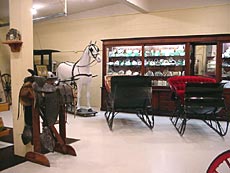
Perhaps
the most important feature of the Funk Prairie Home is that it still
keeps the feeling of the comfortable, welcoming place it was in the
days when the man who built it, Lafayette Funk, entertained
important political and business leaders there. This impression is
helped along by the tour given by guide and caretaker Bill Case, who
somehow makes you feel you are one of those honored guests who were
entertained by LaFayette and his wife Elizabeth.
"The
Funks knew what hospitality was and how to make you feel at
home," Case says. "Our mission, different from that in the
grand showplace homes like the David Davis mansion in Bloomington,
is to educate people about the Funk family and life back when they
were living here.
"We
want people to feel like they’ve been in a home, not in a museum.
We want them to feel they’ve been a part of what they are seeing.
The tour is about the people who lived here, not just about the
stuff you see here. History isn’t just stuff."
The
"stuff" in the 13-room house, however, reflects the
interesting lives of the Funk family, as does the house itself.
Built in 1863-64, it was a wedding present for Elizabeth Paullin of
Ohio, whom LaFayette met and fell in love with while in college.
Although
LaFayette insisted upon bringing his bride to a comfortable and
spacious home, he himself was born and spent his early years in a
log cabin. His father, Isaac Funk, a man of German descent who come
to Illinois from Ohio, and his mother, Cassandra Sharp of the Fort
Clark area (now Peoria), homesteaded on the McLean County prairie in
a one-room cabin located at what is now the Funk’s Grove rest stop
along Interstate 55.
Isaac
and Cassandra had 10 children, nine of whom lived to the age of 50
or more, unusual at that time. LaFayette, the fifth child, was born
in 1834 and died in 1919, when he was 85, two years after he broke a
hip cutting ice on a pond. In those times, a broken hip was usually
a death sentence, but LaFayette didn’t think he could die right
away because he still had important work to do.
LaFayette
had incredible energy, Case says. He was 6 feet 3 inches tall, built
like a linebacker, and he would leap out of bed at 4 a.m. because he
couldn’t wait to get to work on his farm.
Still,
he probably wasn’t a match for his father, "iron man"
Isaac Funk, described as "tornadic and dynamic, 6 feet 2 inches
of solid muscle." Isaac broke the prairie sod to plant corn,
raised cattle and hogs and drove them to market, sometimes for
hundreds of miles. He was able to sit in the saddle for as long as
three days without sleep while driving livestock to market.
[to top of second column in
this section]
|
Cassandra
was no fragile prairie flower, either. It was said she could ride
and drive cattle better than any other woman in the area. Most of
her 10 children were born in one of two log cabins, the first one
measuring only 12 by 14 feet —
not as big as one of the rooms in the Prairie Home.
The Isaac Funk family did not move into its first frame home until
1841.
A
Methodist, Isaac was an ardent abolitionist who strongly supported
Abraham Lincoln for president. Lincoln is said to have called him
the most honest and forthright man he ever knew. Isaac, himself a
good hand with an ax, coined the name "railsplitter" for
Lincoln’s campaign.
Before
he died, Isaac accumulated 25,000 acres of fine Illinois land. He
became known as the "cattle king" because of the number of
animals he raised and took to market and his advanced methods of
breeding and raising quality livestock.
He
also found time to serve for a number of years in the Illinois House
of Representatives and in 1862 was appointed to the Illinois Senate
to complete the unexpired term of Richard Oglesby. He was re-elected
in 1864 and attended a session of the Senate on Jan. 14, 1865, just
16 days before his death. (He died on Jan. 30, and Cassandra
followed him three hours later.)
Isaac
was a firm friend of the Union and an enemy of the
"Copperheads," Northerners who sympathized with the South
during the Civil War. His famous Copperhead speech, given in 1863,
was widely reported in the national press and read to Union soldiers
all over the country. Isaac pulled no punches, calling them traitors
and secessionists who deserved hanging, and offering to fight with
any one of them in any manner they chose. He was 65 years old at the
time, but still so strong that when he spoke people could hear him a
block away, and when he pounded his fist on the table, the inkstand
bounded half a dozen inches into the air.
Like
his father, LaFayette was a man of many accomplishments. His full
name was Marquis De LaFayette Funk, in honor of the French general
who helped George Washington in the Revolutionary War.
He was
the first of Isaac’s sons to go to college, and he went to Ohio
Wesleyan because it had a program for scientific farming. (Isaac was
one of the founders of Illinois Wesleyan College in Bloomington.)
There LaFayette met Elizabeth, a gifted musician who lived in a
house that had been a station on the underground railroad.
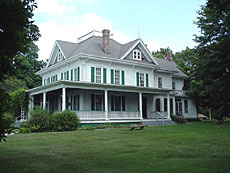
They became engaged, and
he promised to come for her as soon as he built a home for her to
live in. She agreed to wait, though she probably didn’t think it
would take as long as 2½ years. But when she did get to Illinois,
she found a gracious, comfortable 13-room home, surrounded by rich
farmland, where she spent the rest of her life.
(To be continued)
[Joan
Crabb]
[Click
here for Part 2]
|
|
Back
to top |
News
| Sports
| Business
| Rural
Review | Teaching
& Learning | Home
and Family | Tourism
| Obituaries
Community | Perspectives | Law
& Courts | Leisure Time | Spiritual
Life | Health
& Fitness | Letters
to the Editor
|
|

